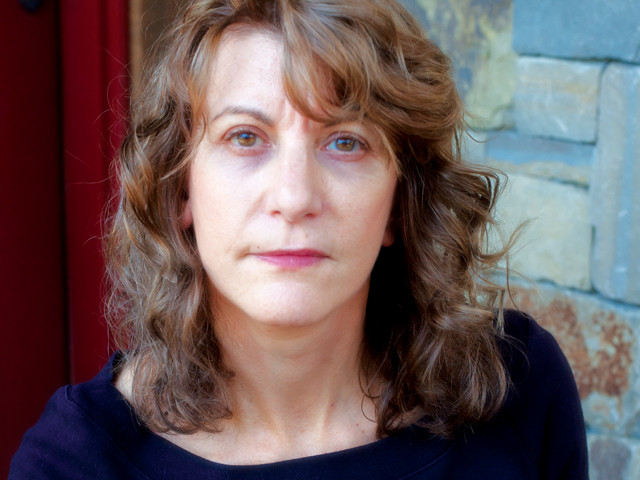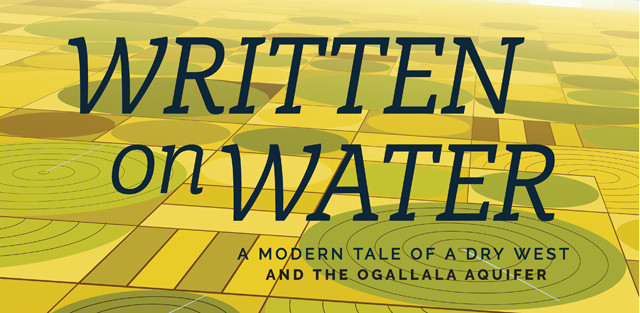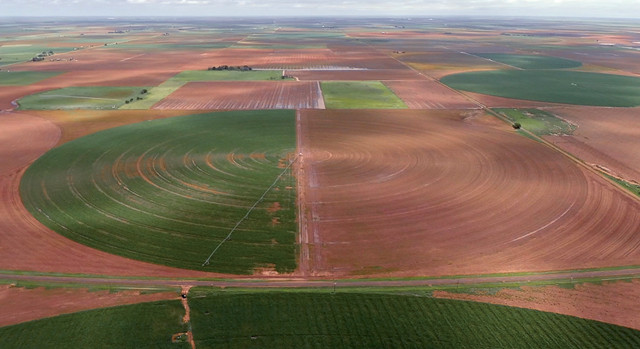
by Kate S. Zalzal Thursday, April 20, 2017

Filmmaker Merri Lisa Trigilio. Credit: Merri Lisa Trigilio.
An endless patchwork of circular fields surrounds the small West Texas town of Olton. The unnatural shapes and sharp boundaries of the brown and green fields result from center-pivot irrigation systems that pull water from the Ogallala Aquifer and allow more crops to grow than the semi-arid landscape would otherwise allow. On these dusty farms and within town offices a drama is unfolding over what to do as irrigation wells run dry.
This drama is the subject of “Written on Water,” a documentary film produced and directed by Merri Lisa Trigilio. Trigilio, who holds a doctorate in geoscience, examines the state of the Ogallala Aquifer and explores the economic, legal and philosophical tensions surrounding the management of the resource as the groundwater supply dwindles in some areas. Set against the backdrop of the windy, near-featureless High Plains landscape around Olton, the film revolves around interviews with local farmers, municipal leaders and water managers as they stake out divergent views on water rights, conservation and the future of irrigated farming.
The Ogallala Aquifer, also known as the High Plains Aquifer, is North America’s largest groundwater resource, covering approximately 450,000 square kilometers beneath Colorado, Kansas, Nebraska, New Mexico, Oklahoma, South Dakota, Texas and Wyoming. It is intensely used, with 97 percent of withdrawals irrigating crops. In return, water from the Ogallala supports more than 20 percent of the grain, beef and cotton in the U.S. The aquifer also supplies 80 percent of the drinking water for people living in the High Plains. But in many areas, particularly in the central and southern High Plains, these withdrawals are occurring faster than the aquifer is recharged, causing substantial water level declines. And in pockets across the High Plains, many farmers, communities, industries and ecosystems are coming up dry.
Tied up in what to do about aquifer depletion is the fundamental legal question of who actually owns the water underfoot. “Written on Water” highlights the patchwork of laws and opinions, which vary from state to state and even within states, and often have limited interest in widespread conservation.
The film doesn’t offer easy answers, but instead focuses on the plights of individual farmers in order to convey the idea that this vast aquifer is finite and in danger of disappearing. Trigilio, in dynamic and compelling fashion, reveals the human side of what is fundamentally a hydrologic and policy dilemma.
EARTH recently spoke with Trigilio about the Ogallala Aquifer, its future and her experiences making the film.

"Written on Water" explores the economic, legal and philosophical tensions around the Ogallala Aquifer. Credit: Merri Lisa Trigilio.
KSZ: In the film, what do you mean when you refer to the Ogallala Aquifer as “sandstone champagne?”
MLT: That phrase was coined by Andy Wilkinson, an artist-in-residence at Texas Tech University in Lubbock and a cowboy poet, who also wrote the music and lyrics featured in the film. The Ogallala Aquifer directly nourishes the people of the High Plains, and it also nourishes us all through its impact on the economy. But the aquifer is something we often take for granted, and we’re using it up. We do this a lot with natural resources that we think will last forever, and we can get “drunk” on the notion of an unlimited resource, as Andy’s song suggests. There are always consequences when you drink too much and the aquifer is like that too. We have to pay the price for our overindulgence.
KSZ: The film looks at the challenges facing the Ogallala and the High Plains region from the perspective of a few farmers in West Texas. What are the “sides” of the issue in that state?
MLT: In Texas, management of common resources is restricted under the Rule of Capture, also called “The Law of the Biggest Pump.” This means that landowners are allowed to pump as much water as they want from wells on their own land regardless of the effects on neighboring wells. There are parts of the aquifer that are doing OK, but if you’re a farmer in West Texas, life is pretty grim. More than 40 percent of all water used in Texas comes from the Ogallala, but many places are depleted, meaning that you cannot use [the aquifer] for agriculture anymore because the energy costs to get it out of the ground are too expensive.
The farmers in the film all believe that they own the water beneath their land. But the issue is whether they support conservation for future generations — which comes with some sort of external oversight and monitoring — or if they view water use as strictly a private property rights issue.
The difference lies between proactive farmers who are trying to implement conservation strategies, and farmers whose first priorities are property rights, rather than conservation. I think these farmers view change and the role of science and technology differently. It is a matter of cultural identity. Many of these farmers have farmed [around Olton] for generations and have similar backgrounds. But the “change-makers” have a real curiosity about their farms, they embrace technology, and they want their kids to have the opportunity to farm there too.
KSZ: How did you choose which farmers to highlight?
MLT: I chose two specific farmers with different viewpoints to highlight in the film because I wanted to show both sides of the issue. If you want to change policy and change minds, you have to understand the other side’s perspective. I think water conservation is critical, but the water rights advocates have a point that some of the [conservation] strategies may make it more difficult for them from a business perspective. If you limit how much they can pump, they feel that they should be compensated because, in Texas, landowners own the groundwater. Some farmers are more creative and better able to adapt to new technology, so in a sense you are inadvertently choosing haves and have-nots.

Center-pivot irrigation systems deliver water from the Ogallala Aquifer to crops throughout the Central United States. Credit: Merri Lisa Trigilio.
KSZ: You have a doctorate in geoscience. Why does the film focus more on people than on science?
MLT: The aquifer and its life-giving water is such a human story. When I started working with the animators for the film to describe what an aquifer is and how it works, I realized that every term we use as scientists has so much knowledge behind it. It is time consuming to explain geologic concepts on screen and if I delved too deep into the hydrology, I thought I might lose my audience — that they would be bored or not care about the important issue. Ultimately, it’s the people who are sustained by this natural resource who are the most moving part of the story.
KSZ: How have droughts in the High Plains region impacted the aquifer?
MLT: The Ogallala Aquifer is a finite resource; we pump six times more water from the aquifer than is replenished through recharge. The Ogallala does not receive recharge from the Rocky Mountains anymore, and rainfall infiltrates very slowly. This is complicated by the fact that, in some parts of the Ogallala, a nearly impenetrable caprock of calcium carbonate prevents rainfall from infiltrating the soil column and getting down to the aquifer. Because replenishment is very low [in some areas], we’re basically mining the aquifer. The drought causes the users, such as power companies, farmers and cities, to accelerate pumping and deplete it at an even faster rate. That’s what happened in Olton, Texas: They thought they had the supply, and when the drought came, they increased pumping rates and the wells went dry.
KSZ: What do you think should be done to address the aquifer depletion problem?
MLT: The problem with an aquifer is that it’s underground. It’s not like a river that dries up and looks bad and then we miss it. But if you drive around the towns that no longer have irrigation and drinking water, there is such a sense of loss and devastation. We need to think about solutions that support both conservation and an agricultural economy.
Farmers can change and rotate their crop types to lower their water usage. Technologies like weather stations, subsurface drip irrigation, remote sensing and satellite imagery can help farmers be more efficient with water, fertilizer and pesticides.
I am also interested in the idea of impact investment and water share programs that use water markets. We need to be careful to protect the consumer, but private investment into these markets may incentivize farmers to use less water, be more efficient and trade water rights. Some of the water savings can then go into wetlands and/or streams that are also suffering due to lack of water.
Groundwater decline is not just happening in the Ogallala, it’s a global issue. There are aquifers in India, the Middle East and Israel that are facing depletion, but some countries have employed successful water conservation programs. If you structure these programs smartly and collaboratively, they can work. After all, what is more important than water?
The screening schedule and viewing options for “Written on Water” are available at www.writtenonwater-themovie.com/.
© 2008-2021. All rights reserved. Any copying, redistribution or retransmission of any of the contents of this service without the expressed written permission of the American Geosciences Institute is expressly prohibited. Click here for all copyright requests.